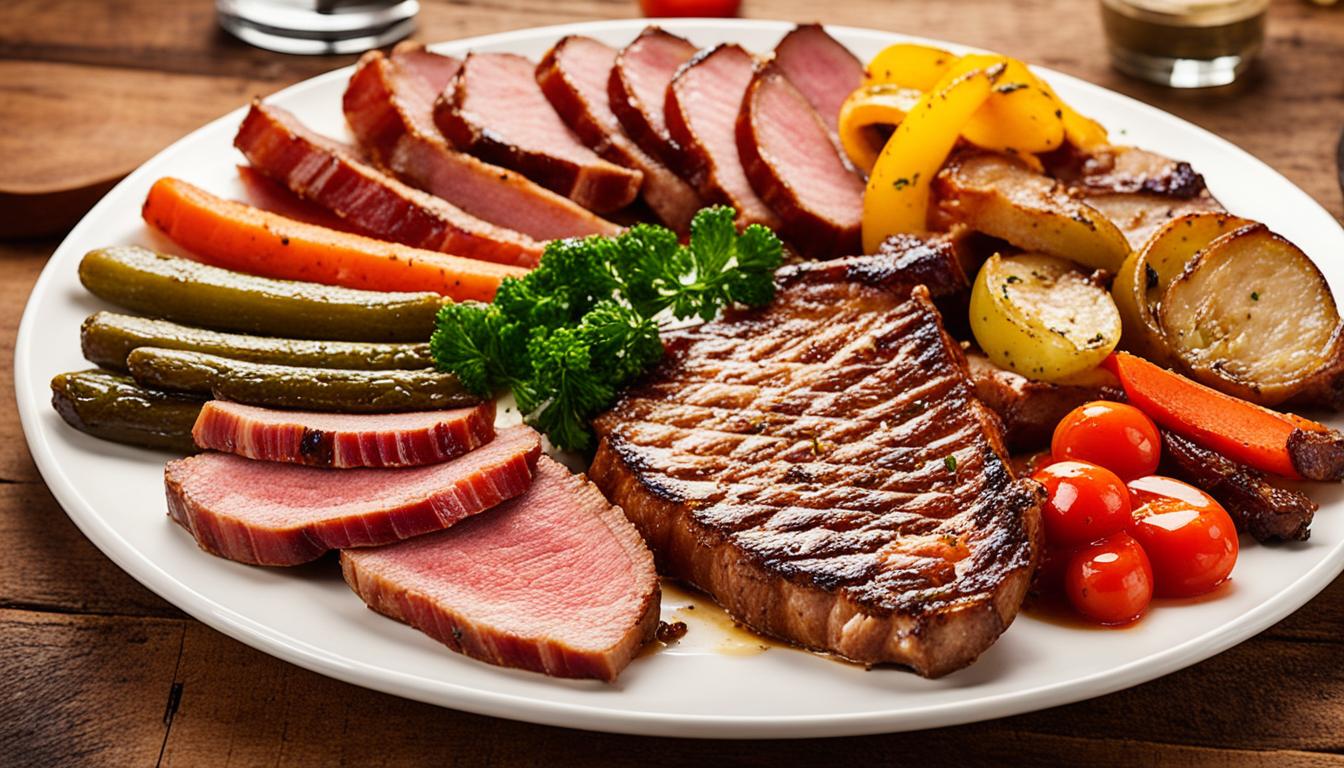Carnivore Diet Meal Plan My Ultimate Guide
I struggled to find the right diet for health and weight until I heard about the carnivore diet. This diet focuses on meat and has become popular for its benefits like better digestion and more energy. Starting this diet, I learned how eating a lot of animal protein can improve health.
In this guide, I’ll share my experience and knowledge of the carnivore diet. You’ll learn how to make a balanced meal plan, pick the best animal proteins, and add healthy fats for nutrition and fullness. This article is for anyone interested in the carnivore diet, whether you’re just starting or have been doing it for a while.
Table of Contents
Key Takeaways
- The carnivore diet is a zero-carb, high-protein eating plan focused on animal products
- Choosing the right animal protein sources is crucial for a balanced carnivore diet meal plan
- Incorporating healthy fats from sources like butter, ghee, tallow, and fatty cuts of meat is essential
- Meal planning and preparation are key to success in the carnivore diet
- Addressing common concerns and challenges, such as nutrient deficiencies and social situations, is important for long-term adherence
Introduction to the Carnivore Diet
I started my health journey and found the carnivore diet. It’s a unique way to eat that goes against the usual advice. This diet focuses on animal foods only, leaving out plants. Many people say it helps with both body and mind health.
What is the Carnivore Diet?
The carnivore diet means eating only animal products like meat, fish, eggs, and some dairy. You cut out all plant foods, including fruits, veggies, grains, and nuts. Followers believe eating animal foods helps them stay healthy and look good.
They think our ancestors ate mostly animal foods and our bodies are made for it. They say eating plants led to many health problems today.
Benefits of the Carnivore Diet
People on the carnivore diet talk about many benefits. Some key advantages include:
- Improved digestion and less inflammation
- More energy and clear thinking
- Feeling full and controlling hunger
- More fat loss and better body shape
- Stable blood sugar and better insulin use
- Less pain from autoimmune diseases and other health issues
The carnivore diet has been a game-changer for me. By focusing on nutrient-dense animal foods, I’ve experienced improved digestion, increased energy, and effortless weight loss.
But, the carnivore diet should be tried with care and with a doctor’s advice. It can be hard and might lead to not getting enough nutrients or making it hard to socialize.
We’ll look more into how to follow the carnivore diet, answer common questions, and see how it can fit different lifestyles. If you’re thinking about trying it, this guide will help you decide.
Getting Started with a Carnivore Diet Meal Plan
Starting a carnivore diet meal plan might seem hard at first. But, understanding the basics and what foods to eat makes it easier. Focus on high-quality animal proteins and healthy fats for good health.
Include a mix of meats like beef, pork, poultry, fish, and organ meats in your diet. These foods are rich in protein and give you the nutrients you need. Try different meats and cooking ways to keep your meals tasty and interesting.
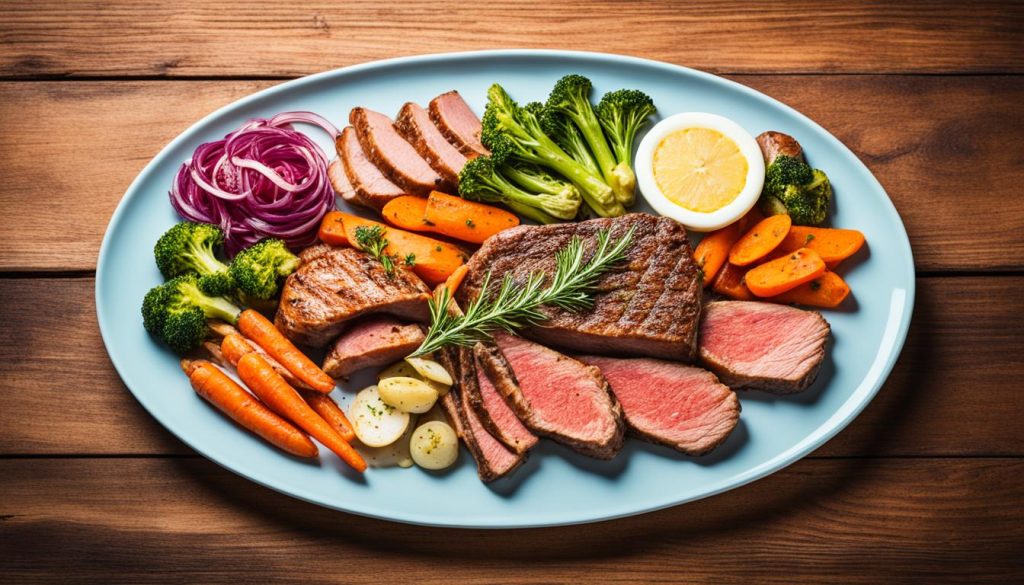
Healthy fats are key in the carnivore diet too. Add butter, ghee, tallow, and lard to your meals for fullness, hormone support, and better vitamin absorption. Choose fatty meats like ribeye steaks or pork belly for flavor and fat content.
“The carnivore diet has been a game-changer for me. By focusing on nutrient-dense animal foods, I’ve experienced improved energy levels, better digestion, and a clearer mind. It’s not always easy, but the benefits are worth it.” – Sarah, long-term carnivore dieter
Listen to your body and drink plenty of water as you start the carnivore diet. You might feel some changes or cravings at first. Be patient and adjust as you go. With time, you’ll get used to it and enjoy the benefits of eating this way.
- Choose high-quality animal protein sources
- Incorporate healthy fats into your meals
- Experiment with different cuts and cooking methods
- Listen to your body and stay hydrated
- Be patient and make adjustments as needed
Follow these tips and enjoy the simplicity of eating only meat. You’ll be on your way to the benefits of this diet, like more energy, a clear mind, better digestion, and overall health.
Choosing the Right Animal Protein Sources
Starting a carnivore diet means picking top-notch animal protein sources for good health. Focus on beef, pork, poultry, fish, seafood, and organ meats for the best nutrition. This ensures your body gets the nutrients it needs to stay healthy.
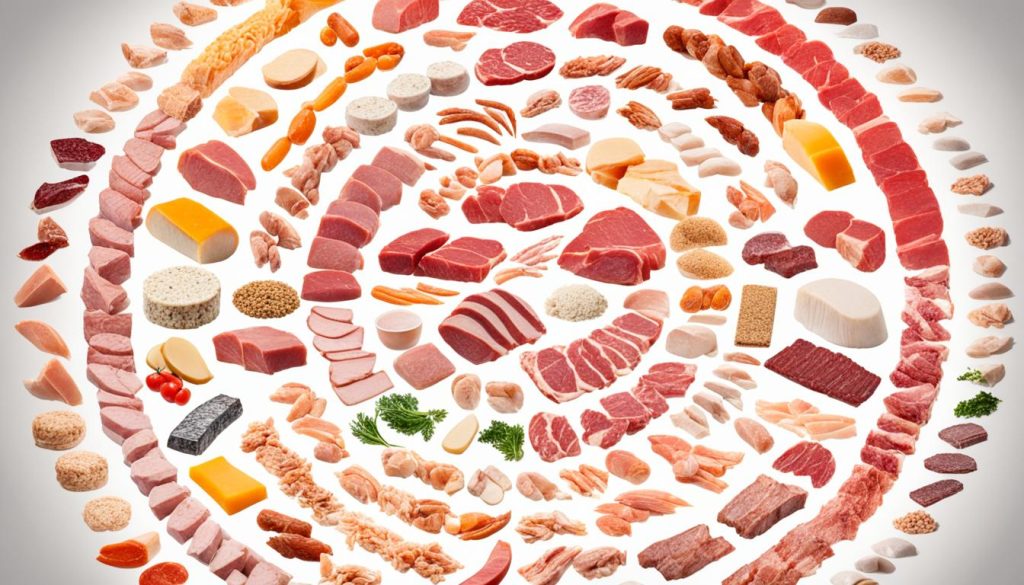
Beef
Beef is key in many carnivore diets, packed with protein, healthy fats, and key nutrients like iron and zinc. Choose grass-fed and grass-finished beef for better fatty acids and nutrients than grain-fed types.
Pork
Pork is great for a carnivore diet, offering protein and fat with nutrients like thiamin and vitamin B6. Go for pasture-raised pork for the best quality and nutrition.
Poultry
Poultry, like chicken and turkey, is a lean protein that fits well in a carnivore diet. It’s full of protein, B vitamins, and minerals like selenium. Opt for free-range or pasture-raised poultry for the best nutrition.
Fish and Seafood
Fish and seafood add quality protein, healthy fats, and nutrients like omega-3s to your diet. Wild-caught salmon and sardines are top choices. These foods support brain function and heart health.
Organ Meats
Organ meats, like liver and heart, are packed with vitamins and minerals. They’re rich in vitamin A and iron. Adding them to your diet helps meet your nutritional needs and supports your health.
Always choose quality over quantity for your animal protein sources. Go for grass-fed, pasture-raised, and wild-caught options to get the most nutrition from your meals.
By picking a variety of high-quality animal proteins, you can make a well-rounded carnivore diet. This diet supports your health goals and overall well-being.
Incorporating Healthy Fats into Your Carnivore Diet
When you’re on a carnivore diet, adding healthy fats is key. They give you energy and help you feel full. Let’s look at some top healthy fats to add to your diet.
Butter and Ghee
Butter and ghee are great for healthy fats, especially from grass-fed cows. Grass-fed butter is packed with vitamin K2 for bones and heart health and butyrate for gut health. Ghee is a good choice if you’re lactose or casein-sensitive because it’s clarified to remove those parts.
Tallow and Lard
Tallow and lard are animal fats used for cooking for ages. Tallow, from beef fat, has lots of healthy fats and a high smoke point. Lard, from pork fat, is also full of healthy fats and vitamin D for bones and immune health. Use them for cooking or to add flavor to your dishes.
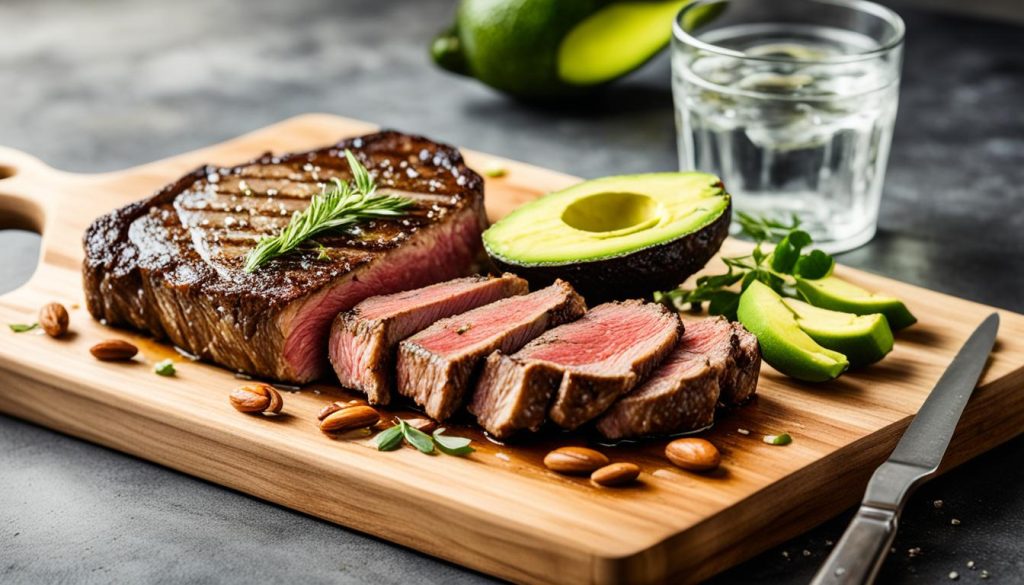
Fatty Cuts of Meat
Choose fatty meats for your diet to get enough healthy fats. Here are some good options:
- Ribeye steaks
- Beef short ribs
- Lamb chops
- Pork belly
- Salmon
- Duck breast
These meats are tasty and have a good mix of protein and fat. They make your meals enjoyable and varied.
| Fat Source | Benefits |
|---|---|
| Grass-fed Butter | Rich in vitamin K2 and butyrate |
| Ghee | Lactose and casein-free, suitable for those with sensitivities |
| Tallow | High in monounsaturated and saturated fats, stable for cooking |
| Lard | Rich in monounsaturated fats and vitamin D |
| Fatty Cuts of Meat | Provide a balance of protein and fat, offer satisfying flavor |
Healthy fats are key for your carnivore diet. They support your health, energy, and satisfaction.
Adding healthy fats like butter, ghee, tallow, lard, and fatty meats makes sure your body gets what it needs. This supports your health on a carnivore diet.
Sample Carnivore Diet Meal Plan
To help you start with the carnivore diet, I’ve made a sample meal plan. It includes a mix of animal proteins and healthy fats. This zero-carb plan shows what a typical day might be like on this diet.
| Meal | Food |
|---|---|
| Breakfast | 3 eggs cooked in butter 4 slices of bacon |
| Lunch | 8 oz grass-fed beef burger 1 slice of cheddar cheese |
| Snack | 2 oz beef jerky 1 oz pork rinds |
| Dinner | 6 oz wild-caught salmon fillet 2 tbsp grass-fed butter |
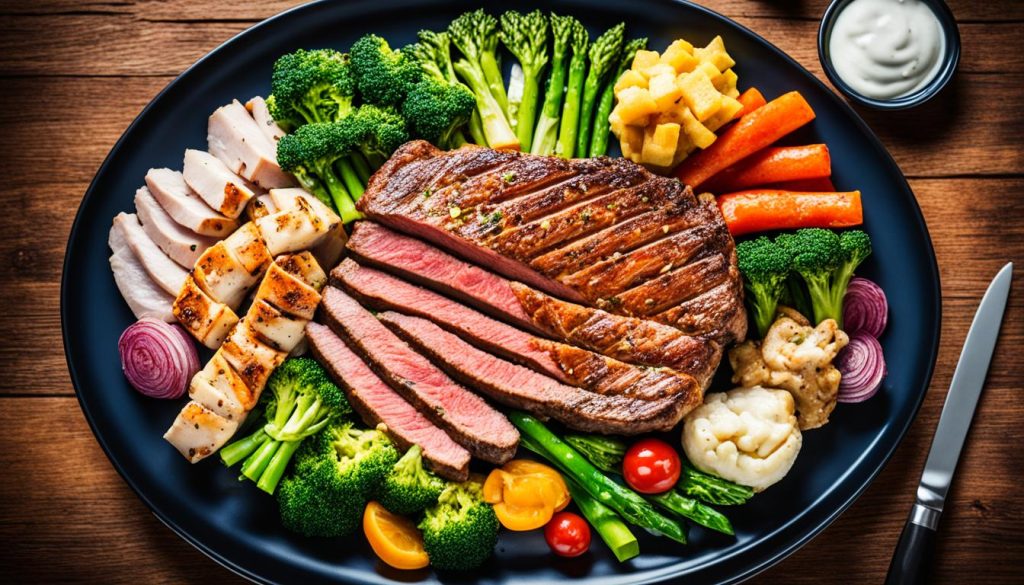
This is just a sample meal plan. You can change it to fit your likes, tolerance, and goals. Some might add dairy like raw cheese or heavy cream. Others might stick to a strict zero carb diet.
The beauty of the carnivore diet is its simplicity. By focusing on high-quality animal proteins and healthy fats, you can create satisfying and nutritious meals without the need for complex recipes or elaborate meal prep.
When making your own carnivore diet meal plan, think about using a variety of animal proteins. Try different meats, organ meats, and seafood. This way, you’ll get a wide range of nutrients and keep your meals interesting and tasty.
Tips for Success on the Carnivore Diet
Starting the carnivore diet is a big change, but with good tips and strategies, you can do well. We’ll look at three key things for doing great on this diet: staying hydrated, listening to your body, and meal prep and planning.
Staying Hydrated
Drinking enough water is very important in the carnivore diet. You might lose more water as you eat more meat. So, drink lots of water every day. Try to have 8-10 glasses, and think about adding things like bone broth or low-carb electrolyte supplements to get back important minerals.
Listening to Your Body
How you react to the carnivore diet can be different for everyone. It’s important to listen to your body. Watch how you feel about hunger, energy, and digestion. If you’re always hungry or tired, you might need to eat more or add more fat. If you have stomach issues, try different meats or cooking ways to see what’s best for you.
Meal Prep and Planning
Planning and prepping your meals is crucial for the carnivore diet. Spend some time each week to get ready for the week. This means you’ll always have good meat and healthy fats ready. It saves time and helps you stick to the diet when you’re busy.
Here are some easy meal prep ideas:
- Batch cooking large portions of ground beef or roasts
- Preparing hard-boiled eggs for quick snacks
- Portioning out and marinating meats for easy grilling or pan-searing
- Stocking up on canned fish like salmon or sardines for convenient protein options
By following these tips – staying hydrated, listening to your body, and focusing on meal prep and planning – you’ll do great on the carnivore diet. Remember, success is about finding what’s best for you.
Addressing Common Concerns and Challenges
Starting a carnivore diet can bring up some worries and hurdles. I’ll cover some common concerns and offer tips to overcome them.
Nutrient Deficiencies
Many worry about not getting enough nutrients on a carnivore diet. But, animal foods are packed with nutrients. By choosing high-quality animal sources, you can get what your body needs.
To get all the nutrients you need, try these:
- Organ meats, such as liver, which are packed with vitamins and minerals
- Fatty fish, like salmon, which provide essential omega-3 fatty acids
- Eggs, are a great source of vitamins A, D, E, and K, as well as choline and selenium
Digestive Issues
Switching to a carnivore diet might cause digestive problems like constipation or diarrhea. These can be fixed with simple steps.
- Stay hydrated by drinking plenty of water throughout the day
- Incorporate bone broth into your diet to support gut health
- Adjust your fat intake gradually to allow your body time to adapt
- Consider supplementing with digestive enzymes to aid in breaking down proteins and fats
Social Situations and Eating Out
Eating out and being with others can be tough on a carnivore diet. But, planning and talking about your diet can help you enjoy meals with others.
Here are some tips for eating out and in social situations:
| Situation | Strategy |
|---|---|
| Restaurants | Look for meat-based dishes on the menu, such as steak, burger patties (without the bun), or grilled chicken. Ask for any sauces or seasonings to be served on the side. |
| Family Gatherings | Communicate your dietary needs to the host in advance. Offer to bring a carnivore-friendly dish to share, such as meatballs or a charcuterie board. |
| Social Events | Eat a satisfying carnivore meal before attending the event to minimize temptation. Focus on enjoying the company and conversation rather than the food. |
Being prepared, open, and committed is key in social situations. With a positive attitude and creativity, you can easily overcome these challenges.
Combining the Carnivore Diet with Other Lifestyles
The carnivore diet is a strong way to eat on its own. But, it can also work well with other diets and lifestyles. This makes it easy to customize your meals to fit your goals and likes. We’ll look at two ways to mix the carnivore diet with others: the ketogenic carnivore diet and intermittent fasting.
Ketogenic Carnivore Diet
The ketogenic carnivore diet combines the carnivore diet with the ketogenic diet’s focus on fats and low carbs. This mix helps you enter ketosis, where your body uses fat for energy. It can lead to more weight loss, better mental focus, and more energy.
To try this diet, pick fatty meats like ribeye steaks and lamb chops. Add healthy fats like butter and ghee to your meals. With low carbs and high fats, you’ll see great results from this diet.
Intermittent Fasting and the Carnivore Diet
Intermittent fasting limits your eating to certain hours. When you do this with the carnivore diet, it boosts fat loss, improves insulin sensitivity, and supports health. This combo is great for your overall well-being.
Here are some fasting plans that go well with the carnivore diet:
- 16/8: Fast for 16 hours and eat within an 8-hour window
- 20/4: Fast for 20 hours and eat within a 4-hour window
- OMAD (One Meal A Day): Consume one large meal per day
I’ve found that combining the carnivore diet with intermittent fasting has been a game-changer for my health and well-being. By eating nutrient-dense animal foods within a compressed eating window, I’ve experienced improved digestion, increased mental clarity, and sustained energy throughout the day.
When mixing the carnivore diet with other lifestyles, pay attention to how your body reacts. Some people do great on a strict ketogenic diet, while others like a more flexible fasting schedule. The important thing is to try different things, watch how you feel, and find what’s best for you.
Conclusion
This ultimate guide has shown how the carnivore diet can change your nutrition. By eating only meat, you can see many benefits. These include better weight control, clearer thinking, and more energy.
Choosing high-quality meats and healthy fats is key. It’s also important to drink plenty of water and plan your meals. You’ll need to handle eating out and social situations too.
Some might worry about getting enough nutrients or having stomach issues. But, these can be fixed with careful planning and listening to your body. Adding things like intermittent fasting can make the diet work even better for you.
The carnivore diet is a strong choice for better health and losing weight. By following this guide and sticking with it, you can feel more alive and well. It’s a way to eat like our ancestors and feel great.
FAQ
What can I eat on a carnivore diet meal plan?
On a carnivore diet, you can eat high-quality animal proteins like beef, pork, and poultry. You can also have fish, seafood, and organic meats. Healthy fats like butter, ghee, tallow, and lard are also allowed.
How do I ensure I’m getting enough nutrients on a carnivore diet?
To get enough nutrients, eat a variety of animal proteins, including organ meats. They are packed with nutrients. If you worry about getting enough nutrients, talk to a healthcare professional. They can check your levels and help adjust your diet if needed.
Can I lose weight on a carnivore diet?
Yes, many people lose weight on this diet. It cuts out carbs and focuses on high-protein, high-fat foods. This can make you feel full, lower insulin levels, and help burn fat.
Is the carnivore diet safe for everyone?
The carnivore diet works well for many, but not everyone. People with kidney disease or gout should be careful. Always talk to a healthcare professional before starting a new diet.
How do I handle social situations and eating out on a carnivore diet?
Handling social eating and dining out can be tough, but it’s doable with planning. Look for simple meat dishes at restaurants, like steak or grilled chicken. Always ask for modifications to fit your diet.
Can I combine the carnivore diet with other dietary approaches, such as the ketogenic diet or intermittent fasting?
Yes, you can mix the carnivore diet with other diets for extra benefits. The ketogenic carnivore diet, for example, combines high-fat, low-carb eating with all meat. Adding intermittent fasting to your carnivore diet can also boost health and well-being.
There are no reviews yet. Be the first one to write one.

